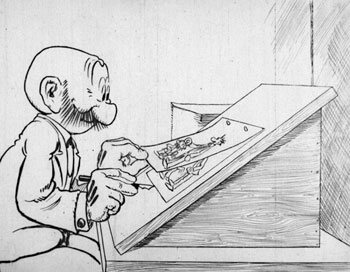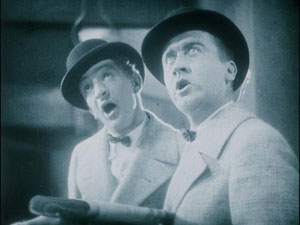International Partnerships
 |
|
Mutt and Jeff: On Strike (1920), one of eight films preserved through the partnership with the National Film and Sound Archive of Australia. Available for viewing here.
|
Only about 20% of the movies produced during the first four decades of American motion pictures survive today in the United States and it has long been assumed that the other 80%, lost through decay and neglect, would never be seen again. Now thanks to the forward-thinking stewardship of the international archive community, we have a second chance to save some of America’s lost cultural heritage.
This rewriting of film history is possible because of the sheer popularity of American movies in the late 1910s and 1920s. Silent-film audiences from Siberia to South Africa learned to savor the excitement and energy of American-made Westerns, serials, melodramas, and comedies. Increasingly, they grew to demand the latest from Hollywood. Distributors sprang up serve the new international market. By 1926, the United States produced about 90 percent of all commercial releases seen worldwide. Over later years, foreign archives salvaged some of the prints some prints left over from international distribution. While exact figures are not available, data collected by the International Federation of Film Archives (FIAF) suggest that hundreds of early works that no longer survive in America exist abroad in at least fragments.
|
Repatriating “Lost” Films: A Fresh Approach
|
In 2008, the National Film and Sound Archive of Australia invited the NFPF to collaborate to preserve eight American eight silent-era shorts long unavailable in our country. Joining forces with the major American silent film archives, the NFPF returned new preservation masters and prints to the United States and posted digital access copies on the NFPF Web site. New copies were also given to our Australian host for study and exhibition. As part of the experiment film graduate students at the University of Michigan researched the rediscovered films and contributed their findings to the NFPF Web site.
Learning of this success, the New Zealand Film Archive invited the National Film Preservation Foundation to undertake a far larger repatriation project. The films come from a cache of scores of nitrate distribution prints safeguarded for decades by the NZFA in remote storage outside of Wellington.
We are now wrapping up this exciting project. Work started in early 2010 when, thanks to a generous grant from The Andrew W. Mellon Foundation, the NFPF sent two American nitrate experts to partner with the NZFA in inspecting the silent-era films. Based on their reports, the American team selected 75 “lost” titles to preserve and make available through the collaboration. During a second inspection trip later that year, also supported by the The Andrew W. Mellon Foundation, more titles were identified and shipped to the United States for preservation. All told, 176 motion pictures were put in the preservation queue; some 70 percent are thought to be the only surviving copy.
 |
|
John Ford's Upstream (1927), one of 176 films preserved through the partnership with the New Zealand Film Archive. Available on the Treasures New Zealand DVD set.
|
Among the discoveries are John Ford’s back-stage comedy Upstream (1927); Maytime (1923), an early feature with Clara Bow; the first surviving film directed by and starring Mabel Normand; an episode of the popular serial The Active Life of Dolly of the Dailies, starring Mary Fuller as the unstoppable woman reporter; Westerns made in Tucson, San Antonio, and Yosemite; the only known narrative feature showcasing the Miller Brothers Wild West Show; comic shorts starring Charles Puffy, Snub Pollard, and Joe Murphy; industrial films about the making of Stetson hats and Dodge cars; a number of documentaries and newsreels; and many more. The earliest film dates from 1898. The American collection also produced a complete surprise—The White Shadow, the earliest surviving feature credited to Alfred Hitchcock, the film’s editor, assistant director, art director, and writer. The British feature, directed by Graham Cutts, carried the logo of its Hollywood distributor and had long been assumed to made in the United States.
Funding the preservation of many titles is a $203,000 grant received through the Save America’s Treasures program, a national initiative targeting the preservation of culturally significant collections, structures, and historic sites that epitomize the creativity of the American people. The federal award, administered by the National Park Service in partnership with the National Endowment for the Arts, required a one-to-one match in private funds and services. We are grateful to the host of public-spirited donors and corporate supporters who stepped forward with matching resources. The corporate honor roll includes Colorlab, Twentieth Century Fox, Sony Pictures Entertainment, Paramount Pictures, Universal Studios, Warner Bros., and Turner Classic Movies.
As the films are preserved on 35mm film, the new copies are made available for study and exhibition through our American archival partners—the Academy of Motion Picture Arts and Sciences, George Eastman House, the Library of Congress, the Museum of Modern Art, and UCLA Film & Television Archive. The NFPF posts digital copies of many titles in our website screening room. New copies of the complete films are also being returned to New Zealand with our deepest appreciation. A DVD showcasing the major discoveries was released in September 2013. Please check back for more news about international partnerships.
